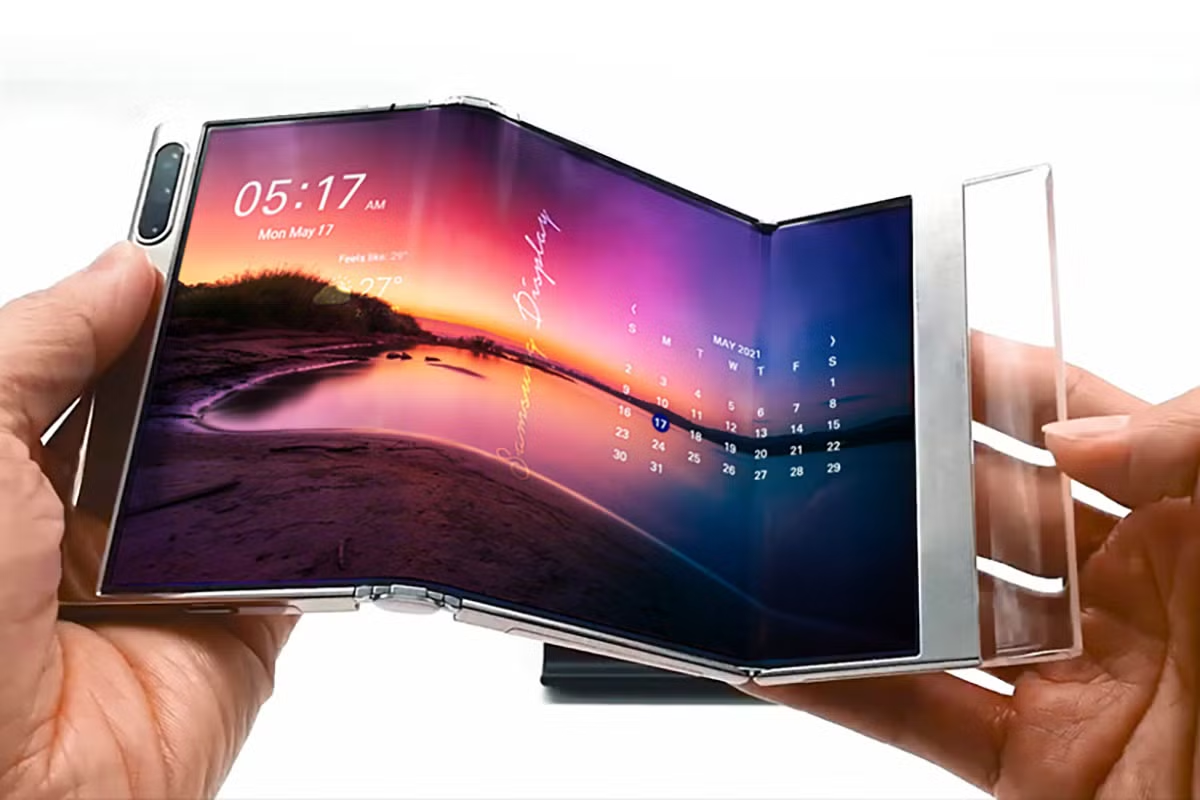Introduction
In early 2025, Samsung Display stunned tech enthusiasts at Mobile World Congress (MWC 2025) with a stunning lineup of futuristic display innovations. These included stretchable screens, foldable gaming consoles, compact TVs that fold into briefcases, and modular OLED panels—all pushing display form factors beyond today’s limits.
1. Stretchable OLED Display – +25% Expansion

Perhaps the most eye‑catching concept was the Stretchable OLED Display—a screen that elastically stretches horizontally up to approximately 125% (i.e. 25% larger) while maintaining clarity and pixel density of ~120 ppi.
During the demo, a football image visually “inflated” as the display expanded. Viewers were captivated by the fluid deformation in near‑real time. Although still in prototype form, this breakthrough points toward future wearables, adaptive signage, and interactive gaming UIs.
2. Flexible Cabinbag / “Briefcase TV” – 18.1″ Folding OLED

Samsung introduced an 18.1-inch foldable OLED screen neatly embedded in a metallic “briefcase,” dubbed the Flexible Cabinbag (sometimes called Flexible Briefcase). When folded, it appears as a conventional carrying case; when opened, it unfolds into a tablet-sized display equivalent to two standard tablets in resolution (~2000×2644, ~184 ppi).
Designed for mobility, it includes handles, ports, and controls integrated into housing. The device serves as a portable TV, presentation screen, or workstation display, showcasing On‑Cell Film (OCF) technology for brighter visuals at lower power.
3. Flex Gaming Console – Pocket‑folding Handheld

Flex Gaming is a bold concept for a handheld gaming console with a 7.2-inch foldable OLED display. Folding like a Galaxy Z Flip, it tucks compactly into a pocket while housing joystick cavities, directional pads, buttons, and a USB‑C port .
It promises to blend Steam Deck‑style power with Switch‑like portability—and Samsung even arranged booth demos running games like Krafton’s InZOI, using Light Field Display tech for glasses‑free 3D visuals.
4. Polygon Foldable (Diamond‑shaped Exterior Display)

Samsung revealed a 3.38-inch diamond‑shaped OLED display dubbed Polygon Foldable. This geometric panel is intended as an exterior screen for flip‑style (clam-shell) foldable phones. Cut through precise laser processing, the unusual form factor challenges rectangular norms.
5. OLED Tile Modular Display

The OLED Tile composed a mosaic of ten 6.8-inch bezel-thin OLED panels and two 31.5-inch monitors to mimic stained‑glass visuals of Spain’s Sagrada Familia. The ultra-thin bezels (~0.6 mm, ~40% slimmer than typical) made the assembly appear as a single seamless large-screen display.
This modular system exemplifies how bezel-optimization and tileable screens enable flexible installations in signage, retail, and art spaces.
6. Seamless Color Studio – Multi‑screen Color Consistency

At the “Seamless Color Studio,” Samsung displayed the same content seamlessly across a 6.7‑inch smartphone, a 16‑inch laptop, and a 31.5‑inch monitor—demonstrating consistent hues, black levels, and brightness that LCDs struggle to match.
This consistency underscores the advantage of OLED’s color uniformity across form factors and paves the way for cohesive multi‑device ecosystems.
7. Ultra‑High‑Brightness OCF OLED (Up to 5,000 nits)

Samsung demonstrated OCF (On‑Cell Film) OLED technology capable of achieving peak brightness levels up to 5,000 nits at 10% on‑pixel ratio. This represents roughly 1.5× the brightness of standard OLEDs while consuming no extra power and maintaining slim panel profiles.
Such high brightness enables outdoor visibility and improved HDR playback, while low power consumption benefits portable devices.
8. Ultra‑Thin UT One OLED Panel

At Computex 2025, Samsung introduced UT One, a next-gen ultra-thin OLED panel built without upper glass—replaced by organic/inorganic thin films. The result is a ~30% thinner and lighter display than conventional panels, along with adaptive refresh rates from 1 Hz to 120 Hz via oxide TFTs and improved energy efficiency (~30% lower).
This technology is well‑suited for ultrabooks, tablets, and hybrid AI‑driven devices requiring dynamic refresh scaling.
9. Next‑Formfactor AI Concepts: Flex S™, Flex G™, Slidable Duet

Under its Next Formfactor with AI initiative, Samsung unveiled stretchable displays (up to 25% elasticity), Flex S™ and Flex G™ foldable panels, and Slidable Flex Duet, which expands from ~8.1 to 12.4-inch screens. These prototypes blur the line between tablet, phone, and wearable formats, suggesting future AI‑centric UI adaptations.
10. Micro‑LED for Wearables and Ultra‑High Resolution

In addition to OLED innovations, Samsung exhibited a 2.1‑inch micro‑LED display for smartwatches, with ~326 ppi resolution, ~4,000 nits brightness, and millions of microscopic LED chips per panel. This micro‑LED tech delivers superior durability, power saving, and visual fidelity for wrist-worn devices and beyond.
Conclusion
Samsung’s 2025 display innovations—spanning stretchable OLEDs, foldable briefcase‑TVs, portable gaming consoles, and modular tileable panels—demonstrate a bold vision for the next generation of visual devices. While most remain in concept phase, the level of polish and integration suggests a not-so-distant future where screens reshape our daily routine.
As OLED and micro‑LED technologies continue to improve in power efficiency, brightness, flexibility, and form factor, it is anticipated that many of these prototypes will ultimately influence—or even directly spawn—future commercial products.
Samsung has clearly signaled: the display technology frontier is expanding—and consumers should expect screens that are more dynamic, portable, and immersive in the years ahead.
Click here to read more about trending TECH NEWS.
![]()



